In this mystery adventure the System Crashers travel to a small but affluent hamlet in the Barony of Swine, either for personal reasons, for a job, or both. While coming face to face with many facets of societal injustice, the Crashers may uncover a two thousand year old secret at the heart of the faith of the land, tangle with ignorance, prejudice, and a dangerous cult.

Background
A couple of millennia ago the worship of the wild, free, and egalitarian goddess Hestia flourished in the land. But a group of wily generals hatched a plan to gain power and supremacy that would dramatically change the course of society.
They would stage and proliferate a second incarnation of the deity, but make it meek, malleable, and male, so that its followers might be easy to subjugate, and so that men would be seen as the dominant sex. Henceforth, the deity was to be known as Hestitan, god of hearth and family, and the first incarnation decried as a violent god, its worship forbidden and heretical. This worked so well that no one alive today so much as questions it.
No one, except one of the generals; one who fails to die, who lives to this day—though his body is wracked by old age—and who questions the wisdom of it all, with the comfortable power of hindsight.
This general, Albrecht Swine, rules the sprawling environs as baron, and has in his time taken many lovers and wives, and sired many offspring. His latest wife, Baroness Elsa Swine, is—unbeknownst to him—one of the leaders of a secret Cult of the First, with misinformed designs to bring back the First.
For you see, every seven years the cult chooses a young woman as a sacrifice, to hasten the First’s return. The locals believe it’s what brings the hamlet its wealth. The baron abhors the practice, and would try and put an end to it… were he not so engulfed in shapeshifting into a hog and running away from the world’s problems.
See the Appendix for details on Hestitan and the Cult of the First.
Adventure Hooks
- A character with the Forgive those who wronged them, Exonerate them, or Rewrite their history catharses has learned that the Barony of Swine (specifically the baron’s vast collection, or the church’s scriptorium) holds the salient records to what happened.
- Baron Swine or Widow Willa has called the characters here to stop the tributes to the First once and for all.
- A character has had recurring dreams of a lute-playing and singing young woman surrounded by hogs and in need of help. The Barony of Swine is the only one that fits the bill nearby.
Part 1: The Journey
The journey to the hamlet sets up the general geography of the land, allows time for the characters to interact with one another and other characters, and has a possible encounter that allows for familiarizing with the game system.
The characters are traveling to Eld Swinton via carriage. Besides them, a single other traveler is in the coach: Astaroth, who is both intimidated and a little excited to be surrounding by women, and he smells opportunity.
Astaroth
A young man, in dark robes, with dark hair, dark eyes, and pale skin. Accidentally imbued with minor prestidigitation powers by a sorceress as a child—not enough for true wizardly power, but enough to be shunned by society, and thus eventually driven to own the outsider aesthetic and play on people’s fear of him (however misplaced).
- POWER. Astaroth’s one true magic comes courtesy of a black kerchief that reverses gravity above it in a 1m wide and 30m tall cylinder. With his innate prestidigitation he can influence objects and people in this beam a little. Unwilling folks get to roll against his influence, but are likely powerless against the gravity reversal itself.
- EQUIPMENT. He carries an old physician’s case full of questionable healing tonics and operating implements, as well as a selection of restraints.
- HOOK. Astaroth has learned that Eld Swinton is in the throes of a cult of the First and sacrifices young women. Publicly, he’s there to put a stop to it, as is expected of powerful wizards. Secretly, he’s aroused by the idea (a little ashamedly), and seeks to join the cult. He’s considering luring and kidnapping one of the System Crashers, and offering them to the cult.
The Coaching House
The coach arrives after dark to the Dry Nymph coaching house, due to a delay caused by badly maintained roads. The coaching house is an hour’s walk from the hamlet. The carriage driver strongly encourages the characters to spend the night here and travel the rest in the morning. Says the forest is a dangerous place after dark, what with the wild boars and the wild zealots. But he won’t stop them (”I’m not your dad.”).
- He’s not local, but he heard rumors about a rogue sect hiding in these forests, worshipping the forbidden First Incarnation of Hestitan.
At some point during dinner in the coach house, the Leshy attacks.
- If the party decided not to stop at the coaching house, they encounter the Leshy’s children on their way to the hamlet.
Leshy Coach House Attack
The Leshy is an ancient god of the forest, remembered by few, worshipped by even fewer. He is incensed at the presence and rites of the Cult of the First, but makes no distinction between cultists, bystanders, or indeed visitors.
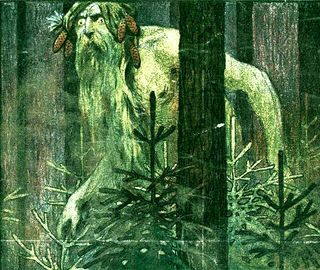
He changes his size to large and breaks through the wall of the coach house and attacks indiscriminately, flinging people, furniture, and hot fireplace irons about. He will call humans ungrateful unbelievers while fighting. If defeated, he turns into a boar and runs away.
LESHY (D1)
May inflict the following conditions:
- Impaled. Pierced by hot iron poker, and pinned to wall. If removed, change the condition to bleeding.
- Broken bone. Hit by tumbling masonry. Roll for afflicted bone: 1) tibia, 2) femur, 3) patella, 4) humerus, 5) clavicle, 6) rib.
- Cut. Injured by flung furniture.
- Painful bruise. Punched, kicked, or shoved.
See the Appendix for an example of play on how this encounter might play out.
Anyone running away will be greeted by the invisible leshonki, the Leshy’s children, who have surrounded the place. They use ventriloquy to lure runners off the path and into enraged wild boars, by mimicking folks in need or monster sounds. They can’t be attacked directly, and their lures have no mechanical effect. It’s up to the players to decide whether or not to investigate screams for help in the forest; since a bunch of guests have likely just run out, it seems plausible. If anyone is injured by a boar, they hear mischievous giggling from the leshonki.
ENRAGED BOAR
- Pierced and bleeding. Direct hit by the boar’s tusk.
- Ravaged flesh. Flung about by the boar.
Should anyone make it as far as back to the swamps, they will encounter Lesovikha, the Leshy’s wife. She is a trickster, luring people into the dangerous swamp.
LESOVIKHA (D2)
- Sprained ankle. Stuck in mud while trying to walk.
- Sinking. Stuck in the swamp, and slowly disappearing. Automatically becomes drowned if no one helps.
Part 2: The Hamlet of Eld Swinton
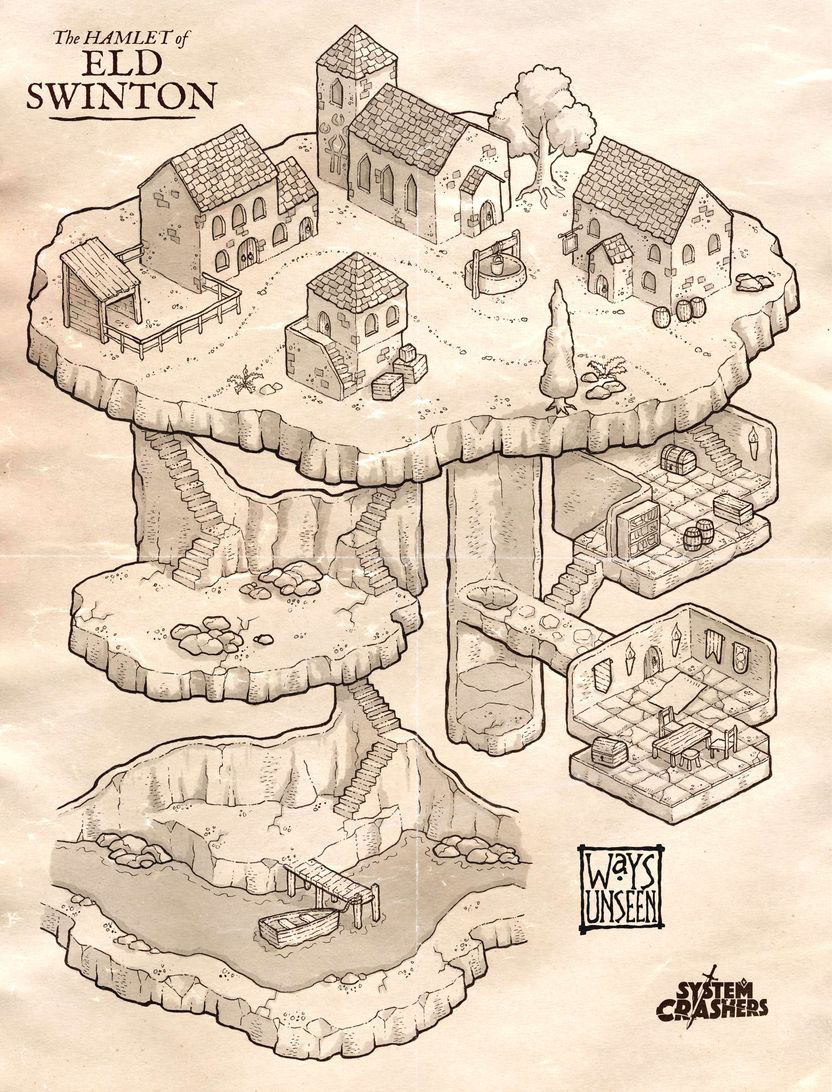
Eld Swinton is the seat of the small but affluent Barony of Swine, ruled over by Baron and Baroness Swine. It’s surrounded by thick forests for a few kilometers, and beyond that, marshland.
Its wealth comes from a thriving hog farm run by the Baron himself, and several farms, including the burgeoning Maddigan farm.
Hog Pen and Shelter
In the corner shelter of the pungent hog pen lie two secrets: a hidden door to the escape tunnels, and a cache with the baron’s ritual book and implements, outlining the spell to shapeshift into a hog.
- EVENT. If the characters go sleuthing in the shelter, a local with a grudge or prejudice might lock them in and set it on fire.
- TREASURE. A grimoire containing a ritual to turn oneself, or a willing or helpless other, into a stocky hog until the next sunrise. The process takes 10 minutes and several arcane implements, all of which are stashed here with the tome.
House Swine’s House
Inconspicuous from the outside, the Swine house is crammed with valuable trinkets and art pieces, ranging from antiquity to now. A statue on the upper landing of an anthropomorphic pig in a suit is the baron’s pride and the baroness’ embarrassment. Unlike more traditional hearths, weapons hang over the fireplace here.
Guests of the hamlet might be afforded one of two rooms in the mansion, children’s bedrooms long since empty (they date back over thirty years, a fact that’s deducible from the fashion and books).
It has all the usual mansion rooms, plus:
- PLOT. A secret locked cellar room, where the couple keep the half-fay daughter Tasha. When she’s not going mad, she spends her time playing the lute and singing, which could be heard from outside the mansion.
- CLUE. The library holds a large chest with all the barony and town records. Perhaps a character’s execution was performed in the barony, and the accounts of what happened are kept here?
- CLUE. Hidden in a secret compartment of the pig statue are the 2000 year old plans to reinvent independent and equality preaching Hestia into patriarchal and docile Hestitan.
- TREASURE. Many valuables whose absence will be easily noticed, the weapons over the fireplace, legal documents.
Baron Albrecht Swine
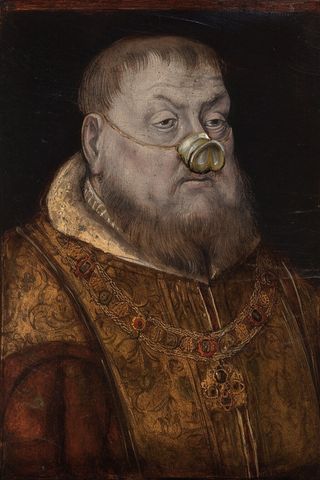
The corpulent, undying ruler of the hamlet. His nose having long rotted away, he wears a golden pig nose. Together with a wig, heavy make-up, and expensive but very old clothes, he strikes an unnerving, imposing figure. Since he has no real need to breathe, he often forgets to for a period of time, only to then mid-sentence push stale air out of his lungs in a dreadful rasp.
- PLOT. Part of a group of generals, who, in ages past, invented the second incarnation of the hitherto wild and independent goddess, reimagining her as a meek, humble, family man; even inventing and martyring a prophet. Nowadays, he looks at society and questions this decision. Were he less apathetic about contemporary human life, he might even do something about it.
- TREASURE. The baron is rich, with wealth amassed over two millennia. Moreover, he has seduced many a woman with lavish gifts (and fear of antagonizing the most powerful man around, a fact he’s somewhat oblivious to).
- CLUE. Knows a ritual to shape-change into a hog. One day he’ll not change back.
- HOOK. The sacrificial tribute is the only thing that enrages the baron. He refuses to give tribute this time. He wants to know how the worshippers of the First get into town and steal the sacrificial victim from the well, once the townsfolk have placed her there.
Baroness Elsa Swine
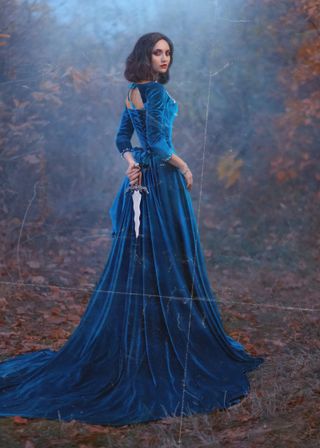
Elsa enjoys her position more than she enjoys her much older husband (even by his assumed age). She wears a valuable, blue dress, and values etiquette and lady-like behavior in public. She is the baron’s wife of 10 years, and doesn’t know (or care) about the baron’s immortality and rituals.
- PLOT. Elsa is secretly one of the leaders of the Cult of the First. Having pieced together information about the First from scraps and left-overs after all records of them were purged and declared heretical, Elsa knows that the First valued gender equality and diversity, but still incorrectly believes them to identify as male, and value female sacrifices.
- HOOK. A tribute from the hamlet is perfectly fine, but a visiting stranger becoming the sacrifice is even better. As one of the cult’s leaders, she has a big say on whom the cult will paint the sacrificial mark (see Events).
Tasha Swine
The offspring of the baron and the wood fairy Dorielle, teenage Tasha has large, sparkling amber irises that identify her as other. Mortified of the world finding out about the baron’s indiscretion, let alone one with an unnatural being, Elsa convinced Albrecht to keep her locked up in a purpose-built secret room, saying that it’s for her own protection against a hostile world.
Tasha has short bouts of lucidity in between long episodes of mania.
- POWER. Her singing and lute-playing can entrance a listener, but it only really works the first time, and in intimate surroundings.
- CLUE. She has acute hearing, and thus knows a lot of going-ons in town, though not the bigger picture.
- HOOK. She knows of her real mother, Dorielle, and desperately wants to be with her.
Church of Hestitan
A warm, cozy temple, dominated by an ever-burning hearth (through labor, not magic) in the middle, surrounded by fur-covered pews, and ringed by beautifully carved statues of perfect families and family life.
- CLUE. The sacristy is a mess of books and scrolls about the history of the religion of the Second, especially its early parts. Leaning lopsided on a heap of books on a desk is a painting of the baron from over 2,000 years ago.
- CLUE. In the same sacristy is an ancient book on faiths, which, among other religions, touches on Hestia and what she stood for. As such, this would be considered a heretical text.
- CLUE. The scriptorium holds a copy of each letter ever written and sent from here. Of note, a recent letter by a worried Pastor Guillem to an infamous group of mercenaries, the Yellowcaps, to come protect them against the heretic worshippers of the First who are due to come take a new tribute. (Also see Events below.)
Pastor Guillem of Hornselby
A young man who’s recently taken on the mantle of local spiritual leader, after the sudden death of his father from an enraged wild boar. He’s handsome, humble, and tries to do the right thing, but is horribly conflicted about the scripture and its gender roles.
- PLOT. Unbeknownst to all, it wasn’t a wild boar at all, but one of the baron’s hogs who’d been secretly fed an experimental growth potion by Farmer Maddigan.
- HOOK. Guillem found a painting of his father as a young boy with the baron, who hasn’t aged a day, and wonders what that is all about.
- CLUE. Has found an ancient scripture that refers to Hestia, and struggles with this.
Eld Swinton Garrison
A two-story tower, with the main quarters and entrance on the upper floor. That floor has an observation corridor that rings a couple of sleeping rooms, a training room, a chill-out corner, and a locked, modest armory. The ground floor holds provisions, a pretty secure cell the key for which is carried by the current unpleasant shift leader.
The place is run by burly, sexist guards. The one female guard is referred to as “one of the boys”, by the others guards, as they don’t consider her attractive.
- TREASURE. A mace made of reddish metal, a sturdy buckler with a dragon motif, a couple of swords with raven-headed pommels, d6 spears, d4 reeking smoke bombs, a secret stash of fermented hog’s milk. A selection of tools and furniture for public punishment or humiliation.
- HOOK. The cell has an interesting occupant: 1) a discovered cultist awaiting lynching—they’ve bitten off their own tongue, 2) Asteroth, who was interrupted trying to kidnap someone, 3) the queen of a nearby barbarian tribe, whom the baron suspected of worship of the First, but has since pretty much forgotten about, 4) Tasha Swine, who managed to escape her own cell at night, but was caught by guards, who obviously don’t know her, and plan to torment what appears to be a fae creature to them.
Well
The noteworthy fact about the well is that it’s used for the sacrificial tributes for cult. They’re bound and lowered into the well and left hanging, and by morning they’re gone. This is achieved through a hidden door leading to the secret complex under the tavern.
- CLUE. A nearby, villager drunkenly mansplains the procedure, and how it will be followed by another seven years of prosperity.
- TREASURE. At one point a cultist lost their horned skull mask down the well, and it’s grown ever more fiercesome in the moss and water.
Hog’s Hoof
The barony’s only drinking hole besides the coach house. Taverner Swill is quick to order his overworked, underpaid, and harassed serving girls around, to serve fermented hog’s milk to customers, especially vaguely affluent out-of-town ones, even if they’re all women.
- PLOT. Any of the named villagers can be often be met here, especially baron, Farmer Maddigan, Widow Willa, Astaroth, or perhaps a cultist sneaking into the secret tunnels.
- CLUE. Swill is blissfully ignorant of the secret tunnels beyond the cellar that have access to the well, as well as a decked out secret meeting place for the cult. One of the serving girls, Juliet, is a cultist and facilitates entry either via the kitchen door or under the pretense to take a patron to a private spot for sex work.
Taverner Henno Swill
What could have been a handsome face is undone by a constant, lopsided smirk on this ultra-conservative barkeep. With a dirty towel over his shoulder, he’s always eager to slander his patrons, or sweat his serving girls.
He is utterly unaware of the secret door to the cult hideout in his cellar, and thinks his macho demeanor will endear him to women.
- HOOK. Wants the Widows gone from the tavern (”old spinsters constantly hanging around is bad for business”).
Widow Willa
An older woman who keeps to hers and herself. In her youth, she was a nun in the nearby Monastery of the Heart and Hearth, until she was chosen by the cult as tribute. She was saved at the last minute, not by a divine act, but an accident. The cult, undecided on whether it was a sign, have let her be so far, regardless.
She is part of the Widows, a trio of older ladies, largely shunned, who spend most days in a corner of the tavern, chatting, playing games, drinking. If asked about the means of her sacrifice, roll a random Death, or pick the one from the character doing the asking.
- HOOK. She wants an end to the cult, and whatever secret tunnels they employ found.
Farmer Maddigan
Unremarkable growing up, Maddigan came to be possessed by the demon Orobas, when the latter escaped the body of the tribute it had consensually inhabited as she was being sacrificed to the First (seven years ago). Now time has turned back for him, he is ruggedly handsome, despite his blood-shot eyes, and is revolutionizing wetlands and marsh farming to great financial gain.
He makes friends and deals easily, and despite the odd jealousy, is very well liked and touted as a local success story. Still single, though. He’s keen on disparaging all faiths, and people thereof.
- HOOK. Maddigan is looking for a suitable wife, though not someone from this backward burgh. He can offer an abundance of worldly goods, satisfy physical needs and desires, but that’s where his talents (and those of Orobas) end.
Escape Tunnels
The baron is a cautious immortal man, and he founded the hamlet at this location because of a natural underground river. He had entrances and passages excavated, but lately has not kept their existences as secret as he perhaps should have: his wife Elsa discovered them and she has divulged them to the rest of the cult.
- TRAP. The bottom of the stairs have pit traps. Four meters down is a loosely attached net, which, if disturbed, rings alarm bells in the baron’s study. They can take one or two light-weight people who don’t squirm too much, before breaking and dropping their charges onto the spikes a further 4 meters below.
SPIKED PIT TRAP (D1)
- Bruised. Grazed and cut from the fall and the spikes.
- Impaled. Immobilized on a spike. If someone freed, turns to bleeding.
- EVENT. A group of aggressive, know-it-all were-eels from the marshes have discovered the passages and are exploring them, and they don’t care for witnesses. Perhaps they’ve gone through the treasures stashed in the boat and throw liquid metal dye concoctions (see Treasure below).
WERE-EEL
- Stunned. Electrically convulsing for a few moments, then burnt.
- Bleeding. A nasty wound from a lightning jolt.
- Infected. Slashed by claws or gnashed by teeth, beginning a slow transformation into a were-eel.
- TREASURE. Stashed in the emergency escape rowing boat is a small but valuable cache of items. Among some iron rations, disguises, and blankets, are several ampules filled with tears of Dorielle and Tasha, respectively, including notes on preparing the magical dyes, and a few ready-made concoctions.
- The tears of Dorielle, when mixed with certain dyes makes an outfit shiny like liquid gold, if they were happy tears, or silver if not.
- Similarly her daughter Tasha’s tears can turn an outfit to liquid petrol, and theoretically to bronze were she to ever shed happy tears.
Events

Use the following events when it makes sense in the characters’ investigation. The cult marking the victim is the crucial one that moves the plot along.
- The pastor gets chatty in the pub about his findings, to anyone who will listen. Widow Willa is particularly interested, whereas Taverner Swill wants him removed.
- The guards have discovered a cultist among the villagers, and instead of interrogating them, they’re joining in with the lynch mob mentality. Choose a character’s particularly gruesome death, and have the mob execute the same. The cultists are fanatics and will not easily reveal anything, even under pain of death. They might be more amenable to people sharing their views though.
- If one or more of the characters have been behaving in an unladylike fashion, or partaking in actions unbecoming of a lady, word might reach Baroness Elsa, who orders them to an afternoon in stocks in public as penance.
- Farmer Maddigan strides into town or into the tavern, with a couple of young, doting and smitten women on his arms. He takes to one of the characters, and asks them out, with the goal of a union, for which he’s willing to make a generous deal.
- A group of mercenaries, the Yellowcaps, arrive in town. About a dozen in number, including a couple of carts and several horses, they loudly proclaim to have come to rid the town of its wicked customs. In truth, they’re robbers and looters, hoping for easy prey.
- The baron is nowhere to be found, it’s as if he’s disappeared into thin air. A thorough search might yield his clothes being munched on by one of his hogs, and a torn grimoire in the hog pen hinting at a shapeshifting ritual. Or a new hog that’s not accounted for: the baron cast the ritual for a last time, and finally it’s permanent.
- Dorielle has whipped up a contingent of forest creatures into attacking the hamlet, to wreak her revenge, and so that she might rescue her daughter. The attackers include boars, mischievous leshonki, barbarian twins turned were-bears, and a demon-possessed rabbit.
- The cult comes into town, either in daylight in large numbers, wearing horned masks, or unseen at night. They mark a young woman with the sign. The townsfolk, superstitious and riled up into a mob by the fiercesome looking cultists, drag her to the well (the next morning, if the cultists came at night), tie her up, and lower her in. Even the guards will stop anyone from interfering.
Conclusion
This adventure concludes naturally when the characters have completed whatever goal has brought them here, or began driving their exploration of the hamlet. Additionally, they may uncover and put a stop to a faith to a made up version of a deity, changing the religious and social landscape of the lands forever.
Appendix
The God Hestitan
Central to the adventure is the worship of the god Hestitan. He is depicted wildly different depending on age of scripture.
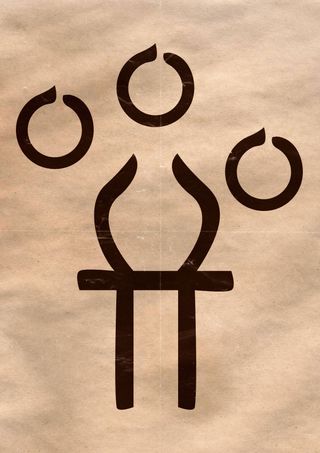
Hestitan the First is described as a wild and violent god, lord of fire, and his worshippers dangerous and impossible to control. In truth, the First was a she: Hestia, who stood fiercely for family, hearth, and gender equality.
Roughly two thousand years ago a group of generals (including the now immortal Baron Swine) concocted the brilliant plan to re-invent the goddess into a much more docile, and thus controllable, one, together with a martyred prophet and all. It worked, and eventually the idea of the First Incarnation became heretical.
The new Hestitan, sometimes referred to as the Second Incarnation, is the god of hearth and family. He stands for patriarchal gender roles and values that have become dominant and ingrained for two millennia. His symbol is a heteronormative family behind a burning hearth/brazier, or a stylized version thereof.
Worship of the First is forbidden, but clusters remain in the wild, and cults operate in secret.
The Cult of the First
A female-led group who have assembled just enough information about the First to believe he was an egalitarian god, who did not put one gender above another. Furthermore, their pieced together information from old, forbidden, and incomplete books, scrolls, and letters, leads them to believe that a sacrifice in the form of a fair maiden every seven years will strengthen the resolve of the First, so that he will eventually throw off the shackles of the Second Incarnation, and return to his former self, who values all people equally. The cultists do not relish the sacrificial act, but see it as imperative for the greater good.
Of course they have a few crucial details wrong: the First was a she, Hestia, and if anything, the sacrifice of men would be more effective. But perhaps even more importantly is that the goddess’ power has waned because the worship has been reduced to tiny pockets, as the people devote themselves to a made up deity—Hestitan—instead.
For the purposes of this adventure, Baroness Elsa Swine is the cult’s figurehead, and they have a secret meeting place in clandestine tunnels under the tavern.
Eld Swinton Environs
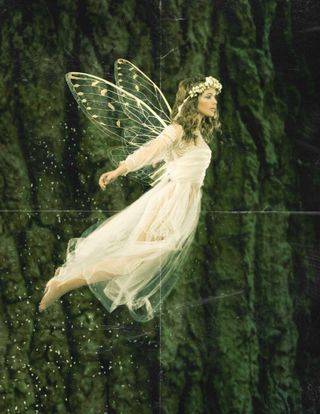
The map shows the center of the hamlet, but more farms and homesteads surround it, dotted through the woods that ring barony’s center. The woods are plentiful with flora and fauna, and it their darker corners things older than the cults of the First still lie, like the forest spirit Leshy and its children. Characters traveling here might encounter enraged boars, playful spirits, or the fairy Dorielle.
Beyond the woods and vast marshlands, seemingly desolate except for the road to Eld Swinton and beyond. The Leshy’s wife Lesovikha lives here, as well as the odd witch recluse, or tribe of were-eels.
Dorielle
Drawn into this world from the Faerie by her love for Anemone the dryad, who long since died to greedy over-logging. Dorielle’s wings were injured when she tried to defend Anemone, and she can no longer truly fly. She looks young and sweet, but she is very old and wise but bitter.
- TREASURE. She knows the secret to making dye that makes clothing shine like liquid metal.
- HOOK. Beyond being with her daughter, Dorielle wants nothing more than to properly fly again. Given the right push, she could then finally fly back into Faerie.
Example of Play
Here is how the Leshy encounter might play out, with a GM and four players.
GM: Your dinner is interrupted by the noise of tumbling stones and breaking timbers, as a large, enraged man literally bursts through the coaching house’s wall, sending furniture flying and patrons scrambling. His long, wild hair and beard are green like the forest, his shoulders and back covered in moss. He’s shouting about ungrateful unbelievers in a dry, gravely tone.
GM: You get the sense that he will throw furniture and debris about, punch and kick, and possibly even hurl hot iron pokers from the fireplace. Livid as he is, you are well past any negotiation stages.
GM: Please describe in general terms, how each of your characters approach the situation, what kind of actions that might perform, and what instrument power or powers, or equipment they might use. You’ll each roll, and the result will dictate the outcome of the whole encounter (unless we get partial successes, and continue fighting).
The Book: I have the book of names, and know this creature’s true name. I will attempt to address it over the din of the fight and berate it for what it is doing, or insinuate that it is bringing shame to its legacy through its violent actions. While I appreciate that I can’t argue with it during this fight, I’m hoping to distract it at least, and give it pause, allowing others to shine, and the other guests to flee.
GM: Indeed, Book, you know that this being is called The Leshy, and ancient spirit or minor god of the forest, largely forgotten.
The Devil: I will help with evacuating the staff and guests and getting them to safety. I will employ my fascination power to get them to focus on me and my instructions, taking advantage of the creature’s distraction from its name being called out.
The Eight of Swords: Now, I don’t have any blades with me, but it strikes me that these hot pokers being flung about and some of the larger splinters from the timbers are awfully similar to swords. Maybe some of the other patrons even carry daggers or rapiers. And I’m sure that some of the cutlery qualifies. Either way, I’ll choose the most dangerous looking blade-like-thing and sing to it, making it fly and spin at my command. I’m going full offensive on this thing.
The Heart: I want to help The Eight fight the creature. Since my character’s death is beheaded, I will offer up my speed death die to her roll, signifying the swiftness with which blades can move and cut.
GM: Great, let’s all prepare to roll then. Now, the Leshy is difficulty 1, which means you’ll need to subtract 1 die from your dice pools. That also means you have to add a death die for any hope of success, unless someone else has already added one for you, like in the case of Heart adding to Eight.
Book: I was burnt at the stake in my original incarnation, and I have a screams death die, which I’ll add, since I’m screaming at the creature. So, base d12, plus death die d12, minus 1 for difficulty—one die. Uh oh, I rolled a 2.
GM: That is a failure, and you take a condition. [Rolls on the Leshy conditions.] You got a painful bruise. The Leshy lashed out at you, flinging you to the ground, winding you. Mark down “painful bruise” as condition, and remember that a condition acts like a extra level of difficulty on rolls, until healed.
Book: Ouch.
Devil: I was crucified, and my death dice are pain, exhibition, and endurance. I’m not sure that any apply to this situation, so I guess I automatically lose?
Heart: Exhibition might work! You want to be seen and heard by the guest you’re trying to coral out, don’t you?
GM: Yes, exhibition is definitely appropriate here.
Devil: Alright then, single die for as well after difficulty then… I got a 6, oh dear! I’m not doing great either!
GM: Indeed. [Rolls for Leshy condition.] Unfortunately you are directly hit by a searing hot iron poker that comes flying through the air. It pierces your shoulder and impales you against one of the massive pillars in the common room here. Mark the impaled condition. Once freed, it turns into the bleeding condition instead.
Eight: Time to end this! I add my weight death die, and Heart’s speed death die. Minus difficulty I’m left with two dice. A 7 and a 10, that’s a success!
GM: Excellent, and also lucky! Had you failed, both you and Heart would have taken a condition, since she aided you with her die. Your dancing blade repeatedly cuts at the enraged creature, fast and deep, and before long you wear him down. He turns into a greenish boar, and flees back into the forest from whence he came. Two of you are injured, but you have saved the day!
